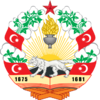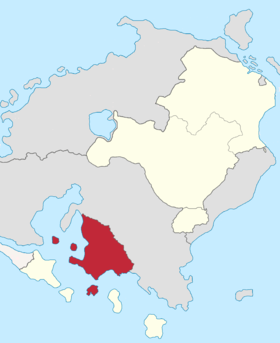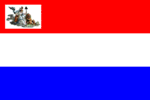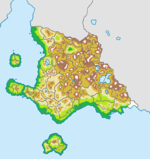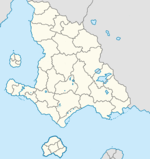Hazar
| Hazar Hazar Eyaleti |
|||
|---|---|---|---|
| State of Thraci Confederation | |||
| State of Hazar Hazar Eyaleti |
|||
|
|||
| Hazar in Thraci Confederation | |||
| Nation | |||
| Establish | 1680 AN | ||
| New lands | 1706 AN | ||
| Administrtative center | Nevişahsınamünhasır | ||
| Government | |||
| • Governor | Berk Bayındıroğlu | ||
| Population (1706 AN) | |||
| • Total | 13,000,000 | ||
| • Estimate (1680 AN) | 11,000,000 | ||
| Demonym | Hazarese | ||
| Demographics | |||
| • Ethnic groups | |||
| Time zone | Central Micras Time (UTC+6) | ||
| Postcode | 10xxx-20xxx | ||
| Area code(s) | 010-020 | ||
| Vehicle registration | HZ | ||
Hazar, full name is Federal Republic of Hazar, constituent nation of Thraci Confederation in Corum. Established in 1681 after than CoRS, in 1681 AN by Ragip Erçolak since 1691 AN. The government form of the nation is the republic.Hazarbashi is Yaşar Talha Bülbül. Hazar's area is 376,891 km2, population is 11,971,141.
The revolution, which started in 1698 in the southern parts of Hanır island and in Ekil city of the Caspian, lasted for two years and captured the capital Hazarkent towards the end of 1699. The Revolution was funded by the minorities and trade unionists in Hanır and managed to get a huge public support. The revolutionaries, pointing to the old revolution in Batavia, adopted the phrase "It may have failed in Batavia, but a definite victory in the Hazar!" as their slogan.
Hazar's Hazarbashi office remains vacant and a group called the Revolutionary Council has replaced the Hazarbashi office. All punishments of stoning and flogging in the country were banned and religions were banned. The Revolutionary Council, which attaches more importance to science than religions, will build four first nuclear facilities.
History

|
This article or section is a work in progress. The information below may be incomplete, outdated, or subject to change. |
Riponian Era
Riponia was once located in Corum before moving to Apollonia. Hazar's history is also told from the first Riponian period. Pre-Thracis were formerly a small nomadic people living in Northern Corum and did not have a state. There was a famine of the period in Northern Corum and Pre-Thracis started to move towards Southern Corum. But their goal was not to establish a state, but to settle in scattered rural areas with little population, which they already accepted Riponian patronage. Pre-Thracis first settled in the so-called Iyatu Plain, when they first settled their numbers were unknown. When Riponia settled in Apollonia, there was no nation left in the area, Pre-Thracis advanced towards the Samin Peninsula and spread widely, some modern items were learned from the city ruins. The name Samin comes from the language of another nomadic people.
Jamzinia Era
With the death of Riponia, the period of anarchy started in the region. Some short-lived principalities ruled in the former Riponian lands, which collapsed due to throne fights. Because of the pre-Thracis throne fights, they could not grow their power by uniting their principalities with another principality, and over time this principal culture began to differentiate. While the signs of the war between the principalities were fully experienced, Jamzinia started to settle in this region. Jamzinia was so strong that the Pre-Thraci resistance was inconclusive, and the principalities still insisted on not joining forces. Pre-Thracis had a good nation at war, but this ability was insignificant since they fought separately. With the destruction of all Ripon tribal resistance in eastern Corum, Pre-Thracis had to return to the Iyatu Plain. The MCS recognized Jamzinia's right to claim, so that the regions officially became Jamzinia's, Jamzinia began to establish its own cities and settle its people. When Pre-Thracis returned to the Iyatu Plain, Pre-Thracis placed emphasis on agriculture and strived to keep well among the other people. Jamzinia had to wait a while to turn green.
Anarchy Era and Han State
The Han State was an ancient confederate tribal community that existed in South Corum between 1550 AN and 1557. In 1569 AN, when he was in anarchy, Han State defeated and bound all the tribes to confederation, thus embellishing a confederation where all tribes were gathered. In 1551 AN, a mass expedition to the west was organized but was unsuccessful, so that the direction of conquest would later take place eastward. In 1552 AN, the army system was introduced, thus gathering power into the army and having an army capable of more regular attacks. In 1553 AN, Incognita captured some of the western lands, the Han State was forced to squeeze eastward. With the Battle of Yuv in 1554 AN, it spread further to the east and strengthened its seat. The year 1555 AN was a complete disaster, Timur Khan passed away and the country lost its unity by being divided among brothers. In 1556, the Eastern Han State collapsed by indigenous tribes and internal revolts, Yalchin Khan had mismanaged the country and could not offer much resources to his army, and thus suffered a deep blow in the wars, and the harsh winter conditions were enough to collapse the economy. In 1557 AN, the Western Han State collapsed, because the ruler Hakan Khan was poisoned and assassinated, and no one could take the head of the country, the indigenous tribes began to rule the interior of the country in a more authoritarian way, which was an end for the Han State.
The Netherlands occupied the region in a short time after the collapse of the Han State, thus Pre-Thracis was again under the authority.
Netherlands Era
During the Netherlands period, there was a state in the present-day Hazar lands and Pre-Thracis lived there, and thus the complete cycle of settlement in today's Hazar lands. Pre-Thracis was heavily influenced by local religions during this period and decided to cease to be warriors, limiting them to expansionism and continuing to live under patronage. Pre-Thracis gave importance to agriculture and they began to congregate in small towns and villages formed, this was the beginning of the formation of permanent settlements. Zözek (former name of Nevişahsınamünhasır), the settlement created by the first Pre-Thraci, attracts a lot of cultural interest today and its structures are still preserved.Pre-Thracis, which changed in terms of religion, still preserved its racial structure, it was forbidden to be marry with foreign people because race had to be protected. Having found peace under the domination of Netherlands, Pre-Thracis would change their destiny after the revolution in 1564 AN and undergo a great change in culture.
Adoption of Umraism
After the revolution in 1564 AN, the name of Netherlands changed and turned into an Islamic state. Pre-Thracis accepted Umraism after the revolution and abandoned some of traditions. This also pointed to the racial change of the Pre-Tracis people, the emphasis was placed on marriage with Umraists, and so over time racial change was undergone, but the tradition was preserved. Mosques were built in the settlements so that people could gather for worship and learn more quickly about their newly adopted religion. Umraism soon became a determining factor in culture. The gradual transition to Umraism continued from 1564 AN to 1582 AN. By the 1570s almost all of the Pre-Thracis adopted the Umraism religion. The economic crisis was looming due to the robbery of recent years, it became a problem for all IIR citizens, and Pre-Thracis became more engaged in aid. Due to the death of the IIR in 1582 AN, the Thraci people began to separate into their own tribes and began to establish their principality, which became a kind of city state. After this period, the Thraci people began to be called only Thracis instead of Pre-Thracis, the states founded by the Thraci people are called Thraco-Umraist states.
Second Anarchy Era
When the period of anarchy entered again, the descendants of some of the former commanders, some of the Thraci tribes were drawn to them and established their principality. The number of big principalities was four, and there were some small principalities, for example Bayındır, Taka, Sümbüloğlu, and Kaçar were included as the great principalities. There were Binyurtoğulları, Koçanoğlu and Alaşoğulları as minor principalities.
Bayındır Principality was a principality that existed between 1583 AN and 1600 AN, the ruler was Alper Bey. It was one of the strongest principalities among them, and it was the first Hazar principality to have a regular army. Architecture and art were given importance, cities were planned skillfully and importance was given to theater. Some scholars came out of this principality and had a say in the state as advisors. Külyurdu Madrasa, Uytu Mosque, Zözek Fortress and Rese Castle are just a few of the structures that have survived until today. The buildings were modern and stone houses for their time rather than adobe houses. This principality lost in the Yılanlı War in 1600 AN, so the capital Zözek was taken by Virtual Nethers.
Taka Principality existed between 1586 AN and 1589 AN, it was the principality that had the first Thraci navy. Very skillful captains were raised within this principality and formed its own pirate units, this navy plundering cities on the banks of Virtual Nethers. Architecturally, it imitated the Bayındır Principality, and militarily had a weak and irregular army on land. This would turn them into disadvantage in the future, when Ardavhi was occupied in 1598 AN, its capital, Akyar, was taken by Virtual Nethers the following year. Ulaş Bey ran away from Akyar and went towards to Chamburr, he would have a state in the future.
Sümbuloğulları was a principality that lived between 1584 AN and 1590 AN, the ruler was Artuk Bey. Principality had a strong army and earned its livelihood by looting and husbandry. The capital of this principality was Afşin (today's disrict of Atlaskent). Architecturally, they could not leave much to the future, the structure of most of their works was adobe. This principality was defeated by the Kaçar Principality in the War of Tanır in 1590 AN and Artuk Bey died in the war.
The Kaçar Principality was a principality that existed between 1583 AN and 1591 AN, their capital was Berzineri. Their ruler was Kaçar Bey, he was a master warrior. The basic means of income was livestock, principality has left some architectural works to the present day. There is not much information about him, after the war in 1591 AN, Kaçar Bey died and Berzineri was captured by Virtual Nethers, many of the sources about the principality were destroyed.
Chamburr Empire
The Thraci people migrated north again after the Virtual Nethers conquered all their lands. Only 560 thousand people remained in today's Hazan lands, 2.5 million people migrated. Many people reached the old town of Chambur after long journeys and often gathered there, while some people settled in rural areas. At that time, a war broke out among themselves again, in this war, the Çanburoğulları became the sole ruler in the region by taking all the tribes under their command, and with the Samin Treaty, all tribes accepted the sovereignty of Çanburoğulları and Harun I, Çanburoğlu House member of I. Harun declared himself the sultan and Chamburr is established in 1605 AN.
In 1508 AN, when the empire was still young, a war broke out between the Virtual Nethers, but no one was victorious. In 1511 AN, the two states fought each other on the Parsak Plain, Chamburr accepted the treaty, and Parsak was captured by the Virtual Nethers. In 1515 AN, the treaty broke down again and the War of Hınçadır started, Chamburr lost the Hınçadır and Chamburr lost the war for the second time in a row. Virtual Nethers was determined to defeat Chamburr, Virtual Nethers deployed the troops to Sada, thirty kilometers south of Chambur, and war broke out again in 1617 AN. In this battle, Chamburr had a good defender and almost had no attack, in 1518 AN the head of Virtual Nethers died in battle and his son was temporarily enthroned.
In 1611, Harun I died and his son, Harun II, took the throne, his first job was to reclaim his former lands within 6 months, and he succeeded. Virtual Nethers had to hang around with Krumerie, a small Nazarene state, which was an advantage for Chamburr. In 1612, a non-aggression pact was signed, and Chamburr never fought on the southern front until 1640, its territory generally remained stable, and the state gave importance to its own internal affairs.
In 1623, Harun II died of organ failure and Kemal I took the throne, and Kemal I gave importance to science and architecture. Government build many schools, and established a system called Lala for the cultured and knowledgeable upbringing of the sultans. Many scientists came out of this period, Hakuri developed primitive water-powered machines, and he drew many structures. Kerem Hasan laid the foundations of literature by writing mesnevi poems and love poems were widely spoken in the nation. Rakım is another famous poet and has always written about the religious love he lived, his travels and his strong faith surprised his readers. Fahrettin Hodja has famous anecdotes, he also wrote some works and his jokes are funny and thought-provoking.
In 1634 AN, Kemal I was assassinated and the fight for the throne flared up. Onur I ascended the throne, but could not rule the nation well at all, the national treasure of the nation robbed the harem for entertainment and people's income began to decline. The army was really weak and unable to deal with riots. At that time a group of wealthy families overthrew the Virtual Nethers government in 1629 and Bodzinak was established. Bodzinak was not a New Batavian state, a minority group of Bodzi people ruled the state, Bodzi people made up 22 percent of the country's population in Virtual Nethers. Bodzinak followed a very repressive policy and was trying to assimilate local peoples, so it has a place in the Hazarese culture. Bodzinak declared war on Chamburr in 1641, and the three-year War of Bodzi-Chamburr was officially under way.In 1641 AN, Bodzinak occupied most of Chamburr, in 1642 AN the Samin peninsula was occupied by Bodzinak and was directly invaded. In 1644 AN, the Bodzinak army invaded the capital Chambur and won the war, with the Babajevo treaty all cities in Chamburr were evacuated and the Thraci people returned to the province of Berkovica, the new name of Bayındır.
In Bodzinak
Bodzinak used to be a state governed nation, the Thraci people lived densely in the states of Samdzak and Berkovica. Bodzinak is a closed box nation, there is little information about the country's internal situation. All Thraci cities were renamed in the Bodzinese language and Bodzinese was the official language. In social life, the Thraci language was spoken informally, Bodzinese was the language that was usually spoken. Over time, the minorities in Bodzinak began to degenerate, something Bodzinak wanted.
Krumeria was occupied in 1647 and became an autonomous state. In 1670, the provinces were abolished, the cities were rebuilt into smaller governments, a good thing for greater control of the minorities, but this move would bring civil war. In 1672 AN, events broke out when the Bodzinese Army executed a Virtual Nethers Again activist, in many cities the actions were violent. With the decision to demolish some his torical monuments in 1672 AN and rename the Zözek Forest and open it for reconstruction, the actions also spread across the Thracis people. When Krumeria invaded and destroyed some Thraci villages in 1673, the pre-civil war took place.
In 1673, Özgür Kale Koruyucuları were established, and the next day Vatan-ı Hazariye was established. Vatan-ı Hazariye offered and accepted an alliance with the Özgür Kale Koruyucuları, who were aiming to bring back the old Bayındır. In 1674, the rulers of some cities joined this alliance, which meant the division of Bodzinak. Civil war officially started in 1675 AN when NVN crossed the borders of Bodzinak and occupied some critical cities.
Bodzinak Civil War
Sharia age
At the end of 1697 AN, Hazan's minister Ragip Erçolak, who had turned himself into an extremist party, declared sharia in the country without any consultation and tried to destroy all the relics left by Alperen Arslan one by one. The head of the Diyanet became his uncle, his uncle was involved in events such as prostitution in the past. Women were prohibited from working.
The harsh interventions and executions of the secularist protesters caused a stir, and the first sparks of the civil war were lit when the revolutionaries of Hanır origin declared Hanır as the "Democratic Republic of Hazar".
Geography
The western shores of Hazar are transverse coastlines and some small and large islets can be found on the western coasts. Hazar has three large islands and fifty tiny islands. The connection between Konır and the mainland is provided by sea transportation and tunnel, Transportation between Hanır and Konır is also settled by sea for now, but transportation will be provided by bridges and tunnels in the future. It is seen that the elevation of Hanır and Konır increases enormously as one goes inside, and the altitude of the city of Batıkonır is high. However, the altitude of Sulak is low and there are not many structures such as hills, Sulak is important for tourism and Birgesh population is increasing. On the mainland, the order of the mountains is parallel to the south of Efsus and the Kurul. The eastern part of the Koruluk is hilly and intercity roads always cross the coast, as transportation will be difficult. The lands of the part where Akyar is located are alluvial soils and the rivers carried soil to this region in time and this region was formed in time. But as you approach the border of New Batavia, the elevation increases enormously and appears to be 2000 meters high. In addition, the north of Efsus is also high, the elevations where Hanbalık is located never falls below 1000 meters. The highest mountain is Gunda Mountain in Büyükcerid and its height is 3212 meters.
The largest lake in Hazar is Binyurt Lake, the area of this lake is 1562 km2. Next to this lake, there is another lake called Ervan Lake, which is 80 km2 in size. Above these two lakes, there is a lake area of 983 km2 called Çardak Lake and this lake is located in the middle of the border of 3 provinces. These three lakes are touristic places during the summer months and the cities are located around the lake, Ervan Lake has become a frequent destination for flamingos. There are four small islands in Binyurt Lake, these islands are uninhabited. In addition, there is a large salt lake on the Tuzyanı-Sinav border and this salt lake turns pink in some months of the year. This salt lake meets 70 percent of Hazar's salt need. Hazar also home to some large and small lakes such as Canbartu Lake, Henen Lagoon, Osmancık Lakes, Kuşyurdu Lake and İspik Lake in some parts in mainland and islands.
Berkovica Reverse Tulip
Berkovica Reverse Tulip is a common flower in Hazar.This plant usually grows in rural areas, it is a common flower almost everywhere in the nation.The average length of this flower is 50-70 cm.The most interesting feature of tulip is that it looks towards the ground unlike other species.The colors of the plant is yellow, orange, red and rarely it is possible to meet the blue reverse tulip.Unlike other flower types, it is a very durable flower species.It has a seed structure similar to onion, this plant should be plant in autumn.There are 5-6 flowers on its branch.
Fifth Mountain Ibex
The Fifth Mountain Ibex,is a goat speices found in mountainous areas on West Hazar. Its range within only Hazar.They just live around Fifth Mountain, so it's quite kind of rare.They have long horns and brown animal skins.Fifth Mountain Ibex stand around 70-90 cm tall at the shoulder and weights circa 75 kg, female Fifth Mountain Ibexs are much smaller ( 50-60 cm tall at the shoulder and weights circa 60 kg.)
Generations were taken under protection by the Hazar Government.Its use in hunting, food and trade is prohibited by law.
Culture
Language
Hazar's official language is Hazarese, Krumeren, Batıry and Borani languages are spoken as minority languages.
Religion
The official religion of the Hazar is Umraism, but the state freed people's beliefs. 97,4% is Umraism, 1,4% is RiSeism, 0,1% is Christian and 1,1% is other religion (Alperenism, Atheism and Antic Egyptian Religion).
RiSeism is a minorty religion of Hazar and second popular religion. RiSeism's origin is Phinbella, and Phinbellan was brought to Hazar by university students. There is a RiSeism chapel in the Burgaz district of the Hazar.
RiSeism has been a fictional religion in Phinbella since the interim government and was established in 2814 following the death of a Phinbellan warrior at the time, Kvong Ri-se died in a traffic accident in Rintis Island. This fictional religion was set up to compete with the religions of Jameelahism and Tzuyuism. This religion has been found on Rintis Island and its surroundings, including the Cyborges, Cyberaya, Carey Islands, Penarik Flyover, Liancourt Rocks, Politama and Boninki Islands.
—Ikmal Hakimi, From a conversation between Ikmal Hakimi and Yaşar Talha Bülbül (1681 AN)
Education
Education is compulsory in Hazar up until age 18, children are required to start primary school at the age of six.Students go on a 3-monthy holiday in the summer, twenty days vacation in the winter, and a weekly vacation in January and April,is happening also weekend hoidays on Saturday, Sunday and Friday in the afternoon.It is a holiday for all students on special days.
Compulsory education is divided into three stages: Primary Education, Secondary Education and High School.Students compulsory for study in school.Students study 4 years in primary education, 4 years in secondary education and 4 years in high school.Individuals who turn eighteen years old take the exam according to their own will, this exam is necessary for university placement.
Universities are divided into two as administration, state and private universities. State universities are directly linked to the state and do not want money, you will be settled with an exam score. Private universities, on the other hand, depend on private companies, individuals and organizations and require money to settle. The best university in the Hazar is Burgaz University, state-owned and located in Burgaz, Hazar.
Sport
Wrestling and Football is most popular sports in Hazar. Wrestling is to be known ancestor football. In the Hazar, you can see that people are wrestling at school or at weddings, wrestling at weedings are tradition. National Oil Wrestling Festival is held in Nevişahsınamünhasır and Atlaskent every year. Hazar is known as "The Land of Wrestlers" among Thracis. Also wrestling is taught compulsory in the military.
Football is a other popular sport in Hazar. Hazar has a professional football league, league name is Süper Lig Hazar. Süper Lig Hazar is top-tier league in Hazar and fourteen teams are in the league. In the Süper Lig Hazar, the last two teams are relegate to Eyalatsal Hazar Liqi. Eyalatsal Amatör Liqi has 6 groups and 84 teams.
Hazar has a top-tier Basketball league, league name is Basgatbal Liqi and league has eight teams.
Ciridinhazarya is very popular.
Demographics
Ethnic Groups
Hazar is has a total population of 19,622,329.
Acoording the 2020 census
Ethnicity in Hazar (1686)
Federations
Millitary
Economy

|
This article or section is a work in progress. The information below may be incomplete, outdated, or subject to change. |
The Hazar is fixed to a near-developed nation economy, it is the wealthiest member of the Thraci Confederation. The nation's sectoral employment share is 25 percent in agriculture, 40 percent in industry and 40 percent in the service sector. Also, in the last 10 years, the population of the nation has grown by 10 million. Although there is a problem for the citizens in tax collection in the country, it seems like a happy nation. There are two national car brands in the country, ULAS Motors and Beta Karoser Motors. The vehicles produced by these two companies cover 59 percent of all vehicles in the Hazar.
ULAS Motors began as a new national automobile company project in 1681 AN after the Hazar's establishment. This project lasted two years and the company was officially established in 1683 AN and started the first automobile production. Farrar International soon had a five percent share in the company. In 1687 AN the company opened a new factory in Salonigrad and began marketing its inexpensive models under the name SAF. In 1688, some Hazar Arslanist Party members founded Beta Karoser Motors as a independent company from government. But the company could not sell more cars than ULAS Motors, in 1692 AN some Sanpanese companies joined the auspices of the Hazarese companies.
Sports facilities have been given great importance recently as a country, small sports complexes were built when the nation was first established, but now they cannot meet their needs. The Süper Lig Hazar was established as an amateur when it was first established and the stadiums were offered to the service of the teams with small stands, but the average audience of the league is increasing incredibly. The New National Stadium, which is the biggest investment in the sports field in the nation, under construction and about to be completed, stadiium will be open in 3th February 2021. Stadium capacity is 56,000 It can be increased up to 65,000.
Hazar also hosts very important companies, some of them are Omega, Millipetrol, Alpsoylar, Saret, Bipa etc. Omega is a mobile operating system company, the company has recently begun to grow rapidly. This operating system has become popular on phones, the company will announce its subsidiary Tupone. Another important company is Millipetrol, this company was nationalized in 1681. The company extracts oil in the Inner Corum Sea and sells it to Millipetrol in same name and other petrol companies.
Foreign Relations
The Hazar used to be a self-governing state and had its own foreign treaties, later on when the was directly included in the confederation, the treaties made in its name were considered valid for the Thraci Confederation.

